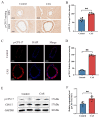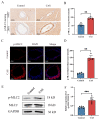Phosphorylated CPI-17 and MLC2 as Biomarkers of Coronary Artery Spasm-Induced Sudden Cardiac Death
- PMID: 38474189
- PMCID: PMC10932290
- DOI: 10.3390/ijms25052941
Phosphorylated CPI-17 and MLC2 as Biomarkers of Coronary Artery Spasm-Induced Sudden Cardiac Death
Abstract
Coronary artery spasm (CAS) plays an important role in the pathogeneses of various ischemic heart diseases and has gradually become a common cause of life-threatening arrhythmia. The specific molecular mechanism of CAS has not been fully elucidated, nor are there any specific diagnostic markers for the condition. Therefore, this study aimed to examine the specific molecular mechanism underlying CAS, and screen for potential diagnostic markers. To this end, we successfully constructed a rat CAS model and achieved in vitro culture of a human coronary-artery smooth-muscle cell (hCASMC) contraction model. Possible molecular mechanisms by which protein kinase C (PKC) regulated CAS through the C kinase-potentiated protein phosphatase 1 inhibitor of 17 kDa (CPI-17)/myosin II regulatory light chain (MLC2) pathway were studied in vivo and in vitro to screen for potential molecular markers of CAS. We performed hematoxylin and eosin staining, myocardial zymogram, and transmission electron microscopy to determine myocardial and coronary artery injury in CAS rats. Then, using immunohistochemical staining, immunofluorescence staining, and Western blotting, we further demonstrated a potential molecular mechanism by which PKC regulated CAS via the CPI-17/MLC2 pathway. The results showed that membrane translocation of PKCα occurred in the coronary arteries of CAS rats. CPI-17/MLC2 signaling was observably activated in coronary arteries undergoing CAS. In addition, in vitro treatment of hCASMCs with angiotensin II (Ang II) increased PKCα membrane translocation while consistently activating CPI-17/MLC2 signaling. Conversely, GF-109203X and calphostin C, specific inhibitors of PKC, inactivated CPI-17/MLC2 signaling. We also collected the coronary artery tissues from deceased subjects suspected to have died of CAS and measured their levels of phosphorylated CPI-17 (p-CPI-17) and MLC2 (p-MLC2). Immunohistochemical staining was positive for p-CPI-17 and p-MLC2 in the tissues of these subjects. These findings suggest that PKCα induced CAS through the CPI-17/MLC2 pathway; therefore, p-CPI-17 and p-MLC2 could be used as potential markers for CAS. Our data provide novel evidence that therapeutic strategies against PKC or CPI-17/MLC2 signaling might be promising in the treatment of CAS.
Keywords: CPI-17/MLC2 signaling; PKC; biomarker; coronary artery spasm.
Conflict of interest statement
The authors declare that the research was conducted in the absence of any commercial or financial relationships that could be construed as potential conflicts of interest.
Figures









Similar articles
-
Phosphorylated Myosin Light Chain 2 (p-MLC2) as a Molecular Marker of Antemortem Coronary Artery Spasm.Med Sci Monit. 2016 Sep 19;22:3316-27. doi: 10.12659/msm.900152. Med Sci Monit. 2016. PMID: 27643564 Free PMC article.
-
SIRT1-mediated deacetylation of NF-κB inhibits the MLCK/MLC2 pathway and the expression of ET-1, thus alleviating the development of coronary artery spasm.Am J Physiol Heart Circ Physiol. 2021 Jan 1;320(1):H458-H468. doi: 10.1152/ajpheart.00366.2020. Epub 2020 Oct 23. Am J Physiol Heart Circ Physiol. 2021. PMID: 33095054
-
Histamine-induced vasoconstriction involves phosphorylation of a specific inhibitor protein for myosin phosphatase by protein kinase C alpha and delta isoforms.J Biol Chem. 2001 Aug 3;276(31):29072-8. doi: 10.1074/jbc.M103206200. Epub 2001 Jun 7. J Biol Chem. 2001. PMID: 11397799
-
[Research Progress and Forensic Application on the Pathogenesis of Coronary Artery Spasm].Fa Yi Xue Za Zhi. 2018 Feb;34(1):60-66. doi: 10.3969/j.issn.1004-5619.2018.01.012. Epub 2018 Feb 25. Fa Yi Xue Za Zhi. 2018. PMID: 29577707 Review. Chinese.
-
Cellular and molecular mechanisms of coronary artery spasm: lessons from animal models.Jpn Circ J. 2000 Jan;64(1):1-12. doi: 10.1253/jcj.64.1. Jpn Circ J. 2000. PMID: 10651199 Review.
References
MeSH terms
Substances
Grants and funding
LinkOut - more resources
Full Text Sources
Molecular Biology Databases
Miscellaneous

